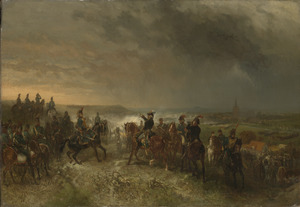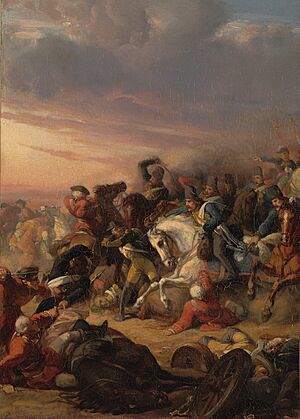Battle of Castricum facts for kids
Quick facts for kids Battle of Castricum |
|||||||
|---|---|---|---|---|---|---|---|
| Part of the Anglo-Russian invasion of Holland | |||||||
 The Battle of Castricum, by Charles Rochussen |
|||||||
|
|||||||
| Belligerents | |||||||
| Commanders and leaders | |||||||
| Strength | |||||||
| 25,700 | 26,400 | ||||||
| Casualties and losses | |||||||
| 1,382 killed, wounded or captured | 2,536 killed, wounded or captured 11 guns lost |
||||||
The Battle of Castricum happened on October 6, 1799, near Castricum, a town in the Netherlands. In this battle, armies from France and the Netherlands fought against forces from Great Britain and Russia. The French and Dutch won this important fight. It was part of a bigger conflict called the War of the Second Coalition, where many European countries were fighting against Revolutionary France.
The French and Dutch forces were led by General Guillaume Brune and Herman Willem Daendels. The British and Russian armies were commanded by the Duke of York, Sir Ralph Abercromby, and the Prince of Orange.
Contents
Why the Battle Happened
In 1799, Great Britain and Russia decided to invade the Netherlands. They wanted to remove the French influence there. This invasion was known as the Anglo-Russian invasion of Holland.
The Invasion Begins
On August 27, 1799, about 32,000 British and Russian soldiers landed in North Holland. They quickly took control of the Dutch navy at Den Helder on August 30. Then, on October 3, they captured the city of Alkmaar.
Leading Up to Castricum
Before the Battle of Castricum, there were other fights. These included battles near Bergen on September 19 and another one near Alkmaar on October 2. This second Alkmaar battle is also called the "2nd Bergen." After these earlier clashes, the British and Russian forces met the French and Dutch armies at Castricum. This set the stage for the big battle on October 6.
The Battle of Castricum
The town of Castricum became a key battleground. Control of the town kept changing hands. First, the French and Dutch held it, then the British and Russians, and back again. This went on several times throughout the day.
Who Won and What They Lost
Finally, the British and Russian forces had to retreat. They suffered heavy losses during the battle. About 2,536 of their soldiers were killed, wounded, or captured. They also lost 11 cannons. The French and Dutch forces had fewer losses, with 1,382 soldiers killed, wounded, or captured.
The Duke's Decision
The defeat at Castricum convinced the Duke of York, who was leading the British forces, that his army could not win. He realized their position was too difficult to hold. After a messy retreat, the two sides decided to negotiate.
What Happened Next
After the battle, the leaders signed an agreement called the Convention of Alkmaar on October 10. This agreement allowed the British and Russian troops to leave the Netherlands.
The Retreat and Its Terms
The British and Russians were allowed to withdraw without paying any money for damages. They also got to keep anything they had captured during the invasion. As a thank you for letting him leave honorably, the Duke of York gave some horses to General Brune, the French commander. By November 19, all the British and Russian soldiers had left the country. This marked the end of their invasion.
Protecting the Netherlands
In the years after the 1799 invasion, new defensive lines were built in Holland. These defenses were designed to protect the city of Amsterdam from any future attacks from the north.
Remembering the Battle
The Battle of Castricum is still remembered in several ways today.
Places of Memory
- In Alkmaar, there's a building called the "Huis met de Kogel" (House with the Cannonball). You can still see a cannonball stuck in its wall from the battle. A special plaque below it tells about the event.
- In Castricum itself, some local names remind people of the battle. For example, there are the "Russenbergen" dunes (Russian Mountains) and the "Doodelaan" street (Death Lane).
- The "Russisch Monument" (Russian Monument) in Bergen marks the fighting that happened there.
A French Victory
The French victory at Castricum was so important that it is even remembered in Paris, France. The name "Alkmaer" (an older spelling of Alkmaar) is carved on the famous Arc de Triomphe. This monument celebrates great French military victories.


